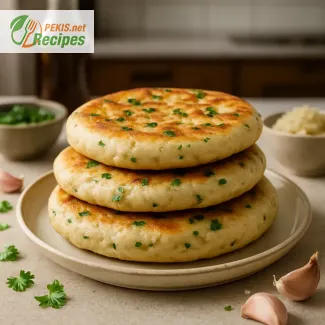
Discover the Rich Tradition Behind Armenian Easter Bread
The cultural heritage and flavor story of sweet choereg
The sweet and aromatic Armenian Choereg is far more than just a festive bread—it's a culinary symbol of heritage, spirituality, and family togetherness. Traditionally prepared during Easter, this soft and golden brioche-style bread holds a revered place in Armenian households around the world. What sets choereg apart from other enriched breads is the use of mahleb, a finely ground spice made from the seeds of wild cherries, which infuses the dough with a subtle almond-cherry aroma that is utterly unique. Sprinkled with toasted sesame seeds and delicately sweetened, choereg is often shaped into braids or coiled rounds, offering both visual beauty and textural richness.
A sweet bread that connects generations
Choereg is not just baked—it is shared. Passed down from grandmother to granddaughter, this recipe brings with it stories, rituals, and deeply rooted memories of Armenian Easter traditions. Every family has their own take on it: some prefer a heavier texture, others a lighter crumb, but what remains constant is the spiritual symbolism of the bread. In many Armenian homes, the preparation of choereg begins on Holy Thursday, when families gather in the kitchen to knead, shape, and bake this sacred loaf together. The experience itself becomes a ritual, blending ancient customs with warm, present-day moments of bonding.
The secret ingredient: Mahleb
The defining element of Armenian choereg is undoubtedly mahleb. This rare and aromatic spice lends the bread its signature flavor—a delicate blend of cherry blossom, almond, and vanilla, which complements the enriched dough perfectly. Though mahleb is not widely used in everyday Western baking, it plays a central role in many Middle Eastern and Mediterranean pastries, making choereg not only unique but also an introduction to Armenian and Levantine flavor profiles. When baked, mahleb develops an enticing fragrance that lingers in the air, announcing to everyone nearby that something truly special is in the oven.
A versatile treat for more than just Easter
While choereg is traditionally prepared for Easter celebrations, it is too delicious to reserve for only one time of the year. Its slightly sweet, buttery flavor and soft, pillowy texture make it ideal for breakfast, brunch, or afternoon tea. It pairs beautifully with a cup of Armenian coffee or herbal tea and can be enjoyed plain or with a spread of jam, butter, or cheese. Some families even transform leftovers into French toast or bread pudding the next day—proof of how beloved and adaptable this bread really is.
The braiding and baking ritual
Shaping the dough is an art in itself. The most iconic form is the braided loaf, symbolizing unity and continuity—both spiritually and culturally. The soft dough is carefully divided into strands and woven together before being brushed with an egg wash that creates a glossy, golden crust during baking. A generous sprinkle of sesame seeds not only adds texture but also reflects the Middle Eastern influences in Armenian cuisine. As it bakes, choereg develops a light, tender crumb and a slightly crisp exterior, creating a perfect balance between softness and structure.
Choereg as a gift of love
In Armenian culture, choereg is often shared as a gift of love and goodwill. During Easter, it’s customary to bake multiple loaves—not only for the family table but also to offer to neighbors, friends, and even local clergy. Each loaf carries a message of hope, joy, and continuity, making it more than a bread—it becomes a token of affection and unity. Gifting choereg is a beautiful gesture that transcends the kitchen, echoing the values of hospitality and community that lie at the heart of Armenian traditions.
The beauty of tradition in every bite
Choereg embodies everything that makes traditional baking so meaningful: heritage, patience, craftsmanship, and love. From the careful blending of spices to the rhythmic braiding of dough, every element of choereg speaks to centuries-old techniques that have stood the test of time. Whether you're baking it for the first time or following a treasured family recipe, each loaf carries with it a sense of belonging and cultural pride.
Why choereg remains timeless
In a world of fast recipes and quick meals, choereg invites us to slow down and honor the process. It’s a reminder that some of the most meaningful dishes are those that require time, attention, and heart. This Armenian Easter bread isn’t just about feeding the body—it’s about nourishing the soul. Every slice tells a story. Every bite brings you closer to a tradition that spans generations and continents.
Whether you're of Armenian heritage or simply a lover of beautiful, flavorful breads, preparing choereg is an experience worth embracing. Its enticing aroma, rich flavor, and symbolic roots make it a timeless classic that continues to bring people together, one braided loaf at a time.
- Activate the yeast: In a small bowl, combine the lukewarm water (60 ml / ¼ cup), 1 teaspoon of the sugar, and yeast (25 g fresh or 10 g dry). Stir gently and let sit for about 10 minutes until frothy and activated.
- Heat the milk and dissolve sugar: In a saucepan, warm the milk (240 ml / 1 cup) just until hot but not boiling. Remove from heat and stir in the remaining sugar (approximately 90 g / a little less than ½ cup) until fully dissolved. Let it cool to lukewarm.
- Prepare the dough: In a large mixing bowl, whisk the eggs (2) until lightly beaten. Add the cooled milk-sugar mixture, melted butter (120 g / ½ cup), vanilla extract (5 ml / 1 tsp), and the frothy yeast mixture. Mix well.
- Add dry ingredients: Gradually stir in the flour (700 g / 5 ¾ cups), salt (5 g / 1 tsp), and ground mahleb (5 g / 1 tsp). Mix until the dough starts to come together, then knead by hand or with a stand mixer fitted with a dough hook for about 8–10 minutes until smooth and elastic.
- First rise: Place the dough in a greased bowl, cover with a clean kitchen towel or plastic wrap, and let rise in a warm, draft-free spot for about 2 hours, or until doubled in size.
- Shape the loaves: Punch down the dough and divide into 6 equal pieces. Roll each piece into a long rope about 30 cm (12 inches) long. Braid 3 ropes together to form one loaf and repeat for the second. Place the braided loaves on a parchment-lined baking sheet.
- Second rise: Cover the loaves lightly and let rise again for about 1 hour until puffy and noticeably risen.
- Glaze and garnish: In a small bowl, whisk together the egg yolk (1) and milk (15 ml / 1 tbsp). Brush the tops of the loaves with the glaze, then sprinkle generously with sesame seeds (15 g / 1 tbsp).
- Bake: Preheat the oven to 180°C (350°F). Bake the loaves for about 25–30 minutes, or until golden brown on top and the bottoms sound hollow when tapped. If browning too quickly, tent loosely with foil.
- Cool: Transfer to a wire rack and let cool completely before slicing. Best enjoyed fresh, but can be wrapped well and stored at room temperature for up to 3 days or frozen for longer keeping.
Creative ways to elevate your homemade Armenian Easter choereg
Expert tips, ingredient swaps, and healthy upgrades for a better result
Traditional Armenian choereg is a deeply symbolic and time-honored bread, but like any classic recipe, it offers plenty of room for refinement and creativity without compromising its roots. Whether you're looking to enhance its aroma, make it healthier, or simply ensure the best possible texture, thoughtful modifications can help you bake choereg that is both authentic and uniquely yours. From ingredient choices to kneading techniques, even subtle tweaks can yield dramatic improvements. Below you'll find expert suggestions and practical guidance to help you master and personalize this iconic Easter bread.
The impact of fat: butter vs. oil or ghee
Butter gives choereg its signature rich, buttery aroma and golden crumb. However, you can experiment with clarified butter (ghee) for a more intense flavor and longer shelf life. Ghee also adds nutty undertones, giving the loaf a more depthful profile.
If you're looking for a lighter version, replace half of the butter with neutral vegetable oil or even light olive oil. This modification can reduce saturated fats slightly and results in a more tender crumb, though the classic buttery scent will be slightly diminished.
Exploring spice variations beyond mahleb
Mahleb is central to choereg’s identity, but adding complementary spices can enrich the flavor. A small pinch of ground cardamom adds floral sweetness and complexity, while grated orange zest brings a fresh, citrusy balance. These additions layer beautifully with mahleb without overwhelming it.
For a bolder profile, a touch of anise seed or fennel offers a slightly licorice-like aroma, perfect for those who enjoy Mediterranean spice combinations. Always keep these in moderation—no more than ½ teaspoon—so as not to clash with the mahleb's delicate tones.
Using enriched flours for a softer crumb
While all-purpose flour is standard, using bread flour can give choereg a slightly chewier and more structured texture due to its higher protein content. However, if you’re after a more delicate bite, consider blending all-purpose flour with a portion of cake flour (up to 20%). This mix results in a more tender, pillow-like interior without sacrificing shape.
Adding 1 tablespoon of milk powder per 250 g of flour can also enhance softness, moisture retention, and flavor depth—especially beneficial if you plan to keep the bread for several days.
Home-baked is always better: freshness and control
One of the greatest advantages of baking choereg at home is control over ingredients and freshness. Store-bought variants often include preservatives and artificial flavorings. By preparing it yourself, you can adjust sugar levels, select organic dairy, or use free-range eggs, creating a bread that’s not only more nutritious, but also more flavorful and aromatic.
Additionally, home-baked bread allows you to tailor the texture—kneading longer for a chewier loaf or shortening the second rise for a slightly denser crumb. It also gives you the option to shape the dough in traditional braids, coils, or even smaller individual buns.
Common mistakes and how to avoid them
1. Using hot milk with yeast: If your milk is too hot, it can kill the yeast and prevent your dough from rising. Always allow it to cool to lukewarm (around 37–40°C / 98–104°F).
2. Over-kneading or under-kneading: Over-kneading leads to a tough texture, while under-kneading results in poor structure. Aim for a smooth, elastic dough that passes the windowpane test.
3. Skipping the second rise: The second proof is essential for creating that light, airy structure. Rushing this step often leads to a denser loaf.
4. Over-baking: Choereg should be golden brown, not dark. Bake until the bottom sounds hollow when tapped. If it browns too quickly, tent it with foil halfway through baking.
More wholesome alternatives without compromising flavor
To reduce sugar without losing sweetness, try substituting up to 25% of the sugar with finely grated apple or pear puree. Not only does this lower refined sugar content, but it also adds natural moisture and a delicate fruity note.
Instead of plain sesame seeds, consider using black sesame seeds or a mix with chia seeds for added fiber and omega-3s. You can also sprinkle the top with rolled oats or crushed almonds for extra texture and nutrition.
Switching from white to whole spelt flour for 30–40% of the total flour amount adds complex flavor and fiber, making the bread more digestible without altering the classic texture too much.
Egg replacements for a vegan variation
If you’re avoiding eggs, try using ground flaxseed mixed with water (1 tbsp flax + 3 tbsp water per egg) or aquafaba (the liquid from canned chickpeas). These alternatives work well in binding and add moisture, though the flavor and color will be slightly different. For glazing, use a mix of plant milk and maple syrup to mimic the egg-wash shine.
Infusing with local character and seasonal twists
Consider giving your choereg a local or seasonal twist by folding in dried fruits such as golden raisins, chopped apricots, or cranberries soaked in orange juice. This not only enhances sweetness but also adds chewiness and natural color to each slice.
In winter months, you might experiment with adding ground cloves or nutmeg for warmth, while in summer, a touch of lemon zest can add brightness. Creating a version with pistachios or walnuts swirled into the dough brings a delightful crunch and Middle Eastern flair.
Letting fermentation work for flavor
For a deeper and more complex flavor, you can experiment with a cold fermentation. After the initial kneading, place the dough in the refrigerator overnight. This slow rise enhances the mahleb's aroma and improves the bread’s structure, resulting in improved texture and taste. The next day, allow the dough to come to room temperature before shaping and baking.
By being mindful of each step and exploring thoughtful enhancements, you can transform the classic Armenian choereg into a personalized, healthier, and even more flavor-rich version of itself. Whether you stick close to tradition or push the boundaries with modern updates, every loaf is a chance to celebrate culture, craftsmanship, and creativity.
Allergens and gluten presence:
Contains gluten, eggs, milk (dairy), and sesame.
Substitution tips for allergens and gluten-free versions:
- Gluten-free version: Replace all-purpose flour with a gluten-free flour blend (ensure it contains xanthan gum or add separately for structure).
- Dairy-free version: Substitute butter with plant-based margarine or refined coconut oil, and use plant milk (e.g., almond or oat) instead of dairy milk.
- Egg-free version: Use egg replacer or a combination of flaxseed meal and water (1 tbsp flax + 3 tbsp water per egg).
- Sesame-free version: Omit sesame seeds or replace with poppy seeds or finely chopped nuts (only if no nut allergies).
- Vitamin A: 210 µg – supports vision and immune function
- Vitamin D: 0.7 µg – aids calcium absorption and bone health
- Vitamin B12: 0.3 µg – essential for red blood cell production
- Iron: 1.7 mg – supports oxygen transport in the body
- Calcium: 45 mg – contributes to bone and dental health
- Magnesium: 18 mg – helps with muscle and nerve function
- Zinc: 0.6 mg – supports immunity and wound healing
- Phosphorus: 75 mg – important for energy metabolism
- Potassium: 95 mg – regulates fluid balance and nerve signals
- Selenium: 8 µg – supports thyroid function and reduces oxidative stress
- Vitamin E: 0.5 mg – protects cells from damage
- Phenolic compounds (from mahleb and sesame): ~15 mg – contribute to anti-inflammatory and heart-protective effects
- Lignans (from sesame seeds): ~20 mg – beneficial for hormonal balance and cardiovascular health





